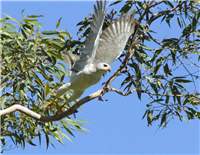Family
Accipitridae
Genus
Accipiter
Species
novaehollandiae
Threats/Control Methods - Regional
Many forests and woodlands in the Grey Goshawk's range are under threat from large-scale land clearing and urban developments. It is estimated that only 0.01% of the adjoining NSW woodlands remain from their original extent.
Threats/Control Methods - Local
This species is not well adapted to the urban environment, due to buildings and a lack of suitably large trees.
Local/Urban Actions
People of the ACT can support revegetation projects of our surrounding woodland by joining local Landcare groups or by participating in a Greening Australia event.
Common Names
Grey Goshawk, Variable Goshawk
Distinguishing Features
This striking bird is 40-50cm in size, with a wingspan of 75-95cm. There are two morphs of this species, one with plumage of softly blending greys and the other snowy white. The grey morph has white under-feathers and fine streaks across its underparts. Both morphs have a short, curved, yellow and black bill and a red eye. Their yellow legs are large and strong, with black, hooked nails.
Survey Techniques
Call and visual identification.
Species Call
A repeated 'kieek-kieek-kieek-kieek'. The male's is high and piercing, while the female's is mellow.
Similar Species
No other birds of prey in this region have these colourings.
Distribution
The Grey Goshawk is found along the coastal fringe of Australia, from the Kimberlys in WA, across NT, down QLD to VIC and TAS.
Country of Origin
Australia
Conservation (Pet/Pest) Status - Regional
This species is very rare to the Canberra region and is only sighted from late November to mid April.
Conservation (Pet/Pest) Status - National
Secure, not listed under the EPBC Act 1999. However, it is uncommon and rare in many areas within its range. In Tasmania, the species is considered Endangered due to ongoing logging.
LSCCES Population
One bird was sighted flying over the ANU campus.
Associated vegetation community
This species inhabits rainforest, mangrove, eucalypt forest and woodland areas.
Limiting Resources
The Grey Goshawk prefers areas with thick, mature tree canopys and open ground vegetation in order to hunt most successfully. It requires large areas of habitat and it not suited to areas with extensive landclearing. Nests are always built near a water source.
Breeding
Grey Goshawks breed regularly during August to December. Their large, shallow nest is constructed of sticks lined with fresh eucalypt leaves. They will also reuse their nest or another raptor's from a previous year. Nests are usually placed high on a strong tree fork in a thick, sheltered tree canopy. The female incubates the 2-3 large white eggs, while the male hunts for the family. The young hatch in a white down after 35 days of incubation. They grow feathers after 2-3 weeks and then leave the nest after 40-45days.
Behaviour
This bird spends time in the thickest tree branches before shooting out swiftly to attack prey on the ground. Its flight consists of strong and direct wingbeats and glides, and young birds are known to wander long distances in search of new territory.
Functional Group
Food Species
Grey Goshawks capture birds, small mammals, reptiles and insects with their strong, clawed feet. They can hunt alone or in groups and are known to often attack Common Starlings (Sturnus vulgaris ).
Predators
There are no know predators of this bird or of the young birds, and the parents will confidently leave the nest unattended for up to 20 minutes. However, this species will hunt other smaller birds.
Interesting Fact
The female Grey Goshawks are the larger of the two sexes and can hunt larger animals than the males.
References - (reader suitability of references, P=Primary teachers, S=Secondary students, T=Tertiary students and researchers)
Books:Morcombe, M. 2000. Field Guide to Australian Birds. Steve Parish Publishing. Archerfield. Australia P, S, T
Veerman, P. 2003. Canberra Birds: A report on the first 21 years of the garden bird survey. Philip Veerman and Canberra Ornithologists Group. Canberra. S, T
Internet: Birds in Backyards. 2006. [online]. Available at:http://www.birdsinbackyards.net P, S, T
Department of Primary Industries and Water. 2007. Threatened Species List - Vertebrate Animals. Tasmania Online. [online]. Available at: http://www.dpiw.tas.gov.au/inter.nsf/WebPages/SJON-58K8WK?open P, S, T
Online Publications:Environment ACT. ACT Government. 2006. Action Plan No. 18: Brown Treecreeper. [online]. Available at:http://www.environment.act.gov.au/__data/assets/pdf_file/13567/actionplans18.pdf S, T
Nix, H. and Cunningham, R. 2006. Birds of the Lower Sullivans Creek Catchment, Canberra ACT. Prepared for the Life in the Suburbs project using data from the Lower Sullivans Creek Catchment Ecological Survey (LSCCES). Australian National University. Canberra. [online]. Available at: http://www.lifeinthesuburbs.com.au/category.php?id=65 S, T

 Top
Top Top
Top